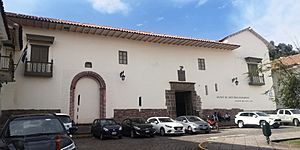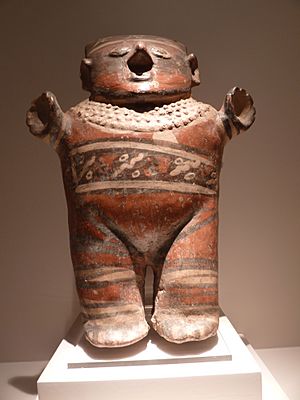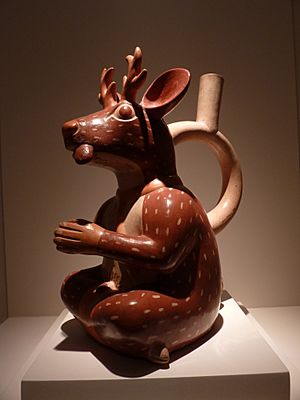Museo de Arte Precolombino, Cusco facts for kids
| Museo de Arte Precolombino de Cusco | |

Facade of the Museum.
|
|
| Established | June 2003 |
|---|---|
| Location | Plazoleta de las Nazarenas, Cusco, Peru |
| Type | Art museum |
| Owner | Larco Museum |
The Pre-Columbian Art Museum (also called MAP) is a special art museum in Cusco, Peru. It shows amazing ancient objects and artworks from different cultures in Peru. These cultures existed long before Christopher Columbus arrived.
The museum is located in Cusco's San Blas area, on Plazoleta de las Nazarenas. It has about 450 unique pieces on display. These items are part of a much larger collection from its main museum, the Larco Museum, which is in Lima, Peru's capital city.
Contents
History of the Museum Building
The building where the museum is now was once an important Inca courthouse. This was a place for ceremonies and legal matters. In 1580, a Spanish explorer named Alonso Díaz took over the building.
Later, it was rebuilt in the Spanish Colonial style. It became the home of a very important person in Cusco, the Viceroy Hernandez de Cabrera. The mansion is still named after him. Over many years, the building was used for different things and eventually became quite old and damaged.
However, a group called the Fundación BBVA helped to restore it. The Pre-Columbian Art Museum then opened its doors in June 2003.
When the museum opened, the Peruvian President Alejandro Toledo spoke at the event. He said that Peru was showing its rich culture to the world. He felt proud that Peru could share its history, which belongs to all of Latin America. He believed that the region should look to its past to build a better future with more health, education, justice, and culture.
Exploring the Exhibitions
The artworks you can see at the museum cover a huge period of time. They range from 1250 BC all the way to AD 1532. There are ten different galleries to explore, each focusing on a specific period or type of art.
These galleries include:
- Formative
- Nasca
- Mochica
- Huari
- Chancay – Chimu
- Inca
- Wood
- Jewelry and Stone
- Silver
- Gold and Metals
The Formative Gallery
The Formative Gallery displays pieces from many different ancient cultures. Some of these include the Cupisnique, Salinar, Vicus, Viru, and Paracas cultures. This period, from 1250 BC to AD 1, saw amazing progress in ceramic art.
Artists started to create beautiful paintings and sculptures. Many pieces show realistic animals or people, while others use symbols. They often used special carving techniques to decorate their art. The Cupisnique artists were especially skilled at this.
The Inca Gallery
The Inca culture was very powerful. They took over a large part of pre-Columbian Peru. They were very clever at organizing their huge empire, called the Tahuantinsuyo.
In the Inca Gallery, you can see magnificent ceramic objects. One famous type is the aribalo, which are large, tall vessels. These pieces have many decorative patterns. These patterns often carry a hidden message about the Inca's organization and beliefs. One of the aribalos in the museum is very large and unique.
Other Things to See
The museum also has an Auditorium that can seat 120 people. This space is often used for talks and other local events.
More Information Online
- Museo de Arte Precolombino | Map Cusco, the museum's official website.
See also
 In Spanish: Museo de Arte Precolombino (Perú) para niños
In Spanish: Museo de Arte Precolombino (Perú) para niños



